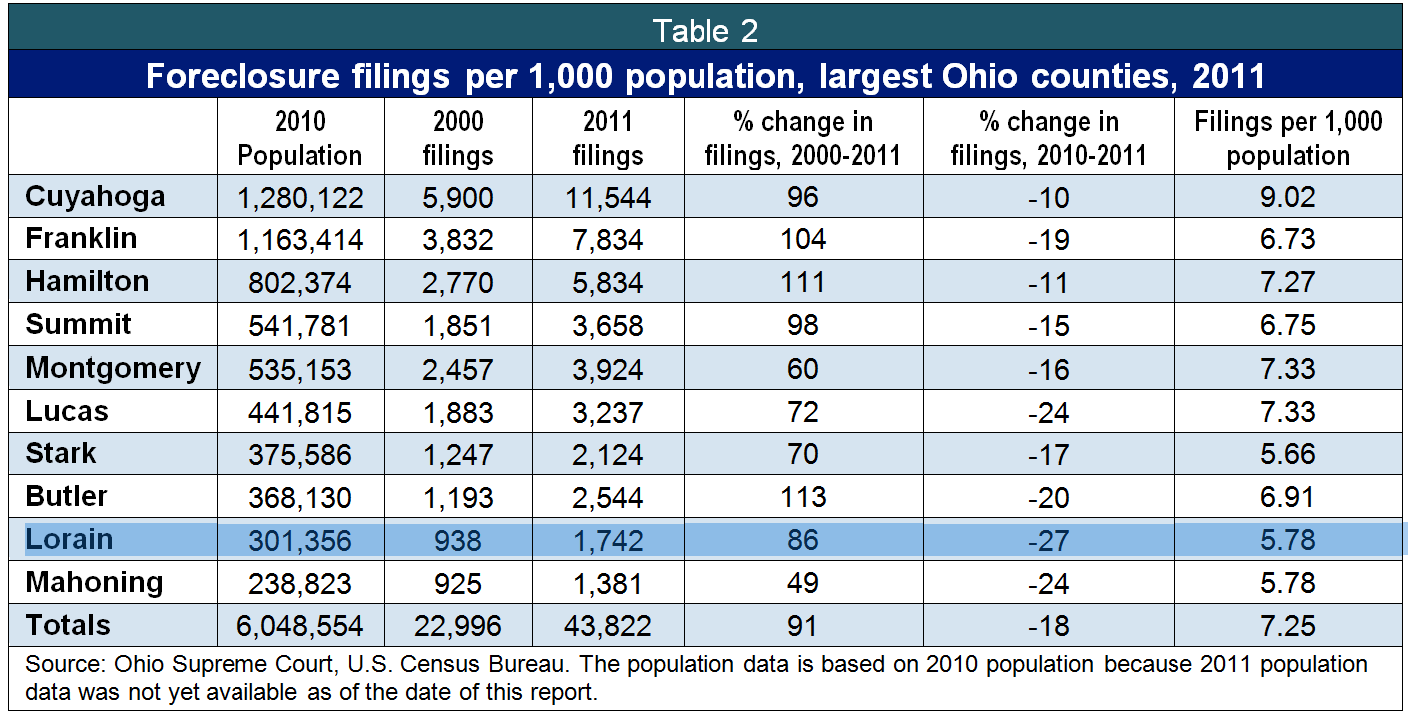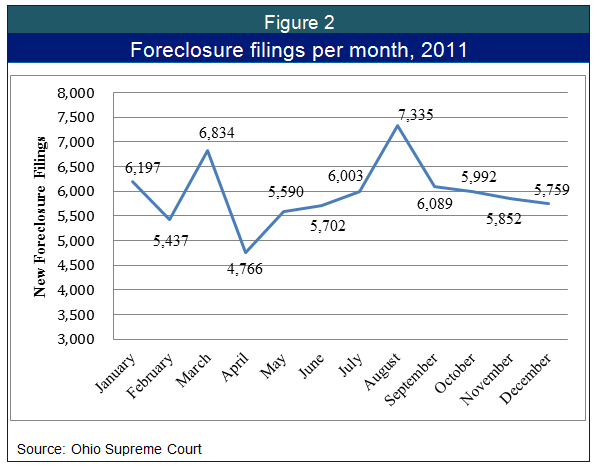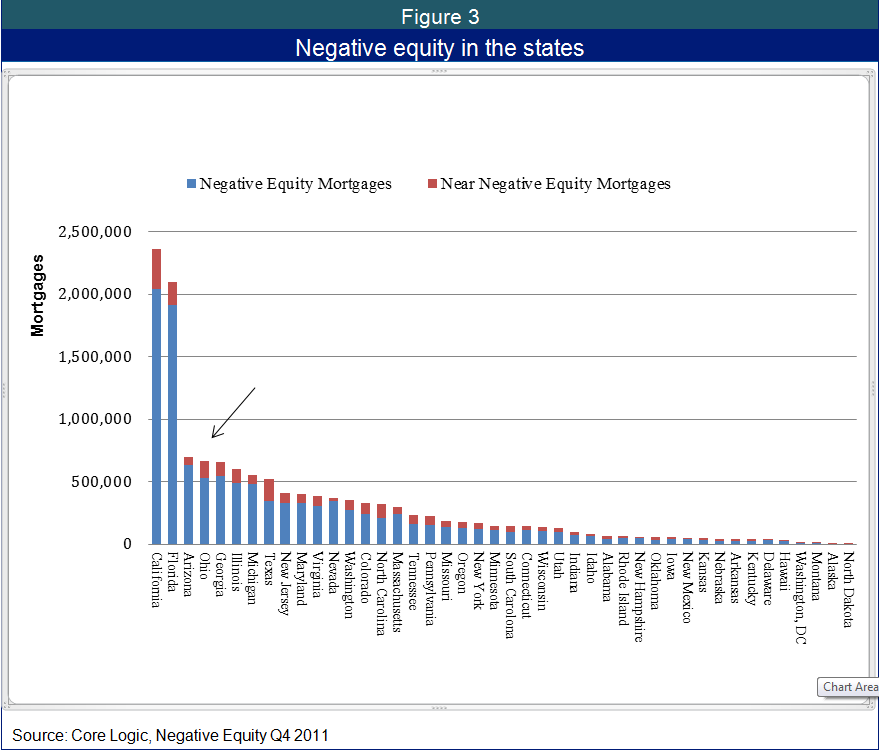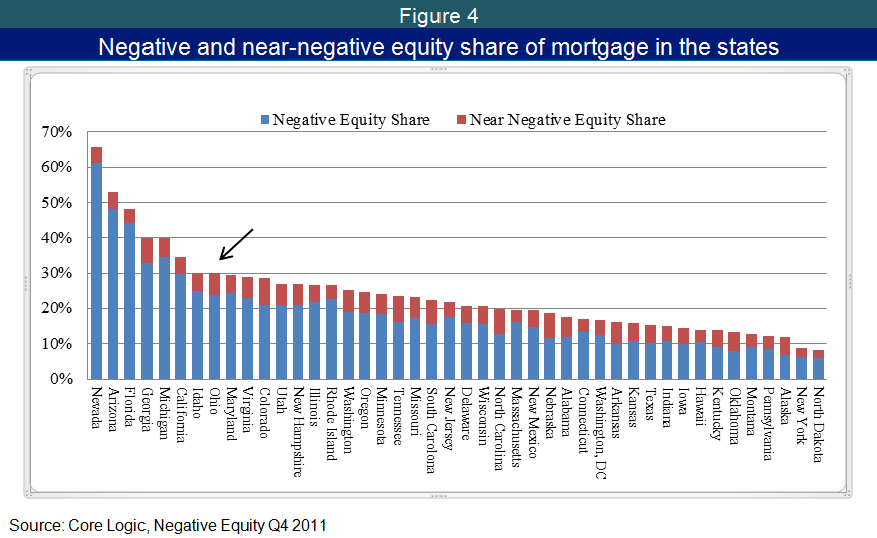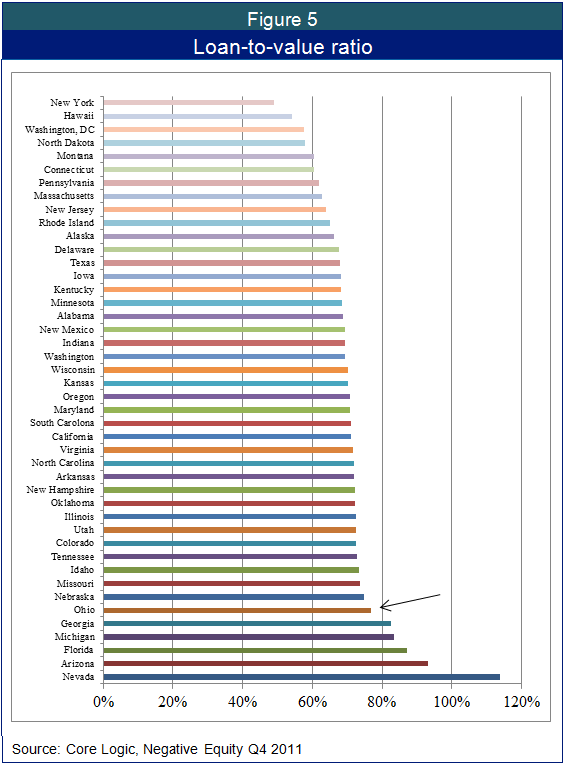
Home insecurity 2012: Foreclosures and housing in Ohio
April 03, 2012
Home insecurity 2012: Foreclosures and housing in Ohio
April 03, 2012
While we’re cautiously optimistic about this decrease in foreclosures, we remain very concerned with the dismal indicators on home equity and delinquent loans. They show that more than one in three homes is ‘under water,’ or worth less than homeowners’ mortgages.Download full report
Executive summary
Press release
 For the second year in a row, Ohio experienced a decrease in new foreclosure filings in 2011. In 2009, Ohio saw more than 89,000 foreclosure filings, more than in any prior year. Since then the rate has declined slightly to 85,483 in 2010 and 71,556 in 2011. This welcome decrease still has Ohio foreclosures at levels that would have been unthinkable in the period prior to 1990. What began as mostly an urban problem in the mid-1990s erupted into a statewide epidemic. Despite recent declines, last year’s rates were still two times higher than they had been a decade before in every Ohio county.
For the second year in a row, Ohio experienced a decrease in new foreclosure filings in 2011. In 2009, Ohio saw more than 89,000 foreclosure filings, more than in any prior year. Since then the rate has declined slightly to 85,483 in 2010 and 71,556 in 2011. This welcome decrease still has Ohio foreclosures at levels that would have been unthinkable in the period prior to 1990. What began as mostly an urban problem in the mid-1990s erupted into a statewide epidemic. Despite recent declines, last year’s rates were still two times higher than they had been a decade before in every Ohio county.
The high level of foreclosures represents a major and ongoing blow against families’ main source of savings and against stability. This report analyzes the new foreclosure filings statistics in Ohio along with some of the latest developments in foreclosure prevention efforts. To add context to the foreclosure numbers, the report provides updates on mortgage defaults and negative equity. It ends with recommendations to better assist individuals, families and communities in becoming more stable.
Data analysis
Ohio foreclosure filings declined last year by 16 percent. In 2011, there were 71,556 new foreclosure filings compared to 85,483 filings in 2010.[1] This decrease in new foreclosure filings comes at a time when more federal and state resources than ever were put toward mortgage modifications. The number of foreclosures in the state remains at crisis levels, higher than in 11 of the last 16 years (see Figure 1). Since 1995, the number of filings has at least quadrupled in 81 of Ohio’s 88 counties and has more than quintupled statewide. However, last year foreclosure filings fell at least slightly in all but two of Ohio’s counties. There was one foreclosure filing for every 71 housing units in the state in 2011.
For the sixth year in a row Cuyahoga County topped the list of foreclosures per 1,000 people (9.02). Coshocton (8.59) and Preble (7.81) followed. Brown (6.56) and Noble (3.28) fell out of the top five to number 13 and 75 while Hamilton (7.27) rose from 15th to the sixth highest ranking. More than half of the most troubled counties, six, were also on the list of counties with the highest rates in 2010.
The number of foreclosure filings is high in urban, rural and suburban counties alike. (see Table 1) Among the top ten counties in filings per person in 2011 were five large urban counties, while in 2007 large urban counties held nine of the ten spots for highest foreclosure filing levels.
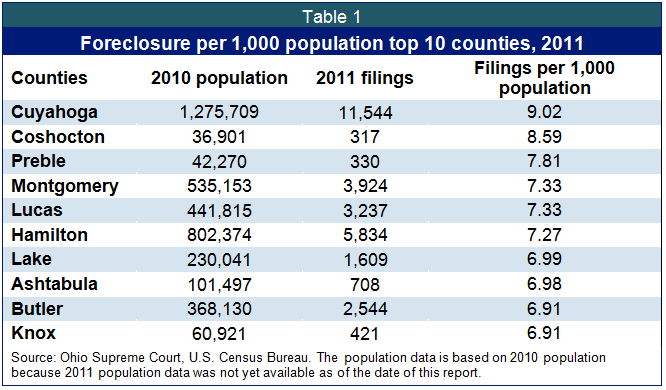 The largest decreases occurred in Lorain (27 percent), Mahoning (24 percent), and Lucas (23 percent) counties. Three large counties, Stark (5.66), Lorain (5.78), and Mahoning (5.78) – had lower foreclosure rates per 1,000 people than the state average (6.2). As in the past, Cuyahoga County had the highest number of filings with 11,544 in 2011. Table 2 shows foreclosure filings in Ohio’s ten largest counties in 2000 and 2011.
The largest decreases occurred in Lorain (27 percent), Mahoning (24 percent), and Lucas (23 percent) counties. Three large counties, Stark (5.66), Lorain (5.78), and Mahoning (5.78) – had lower foreclosure rates per 1,000 people than the state average (6.2). As in the past, Cuyahoga County had the highest number of filings with 11,544 in 2011. Table 2 shows foreclosure filings in Ohio’s ten largest counties in 2000 and 2011.
Figure 2 shows that foreclosure filings varied from month to month in 2011, with a state average of 5,963 filings per month. Filings generally spike in March, but in 2011 they peaked in August.
Several factors related to the current mortgage market and foreclosure process help to explain the decrease in foreclosure filings. First, many of the urban counties where foreclosures grew for more than 10 years have fewer homeowners to foreclose on. This is increasingly evident by the thousands of vacant and abandoned properties in the inner core of Ohio’s cities. Second, many homeowners are working with housing counseling agencies and court mediation programs that dramatically improve their chances of saving their homes. In the last two years, groups put substantial effort into preempting the foreclosure filing process by providing outreach and education before foreclosure.
Two other explanations relate to mortgage servicers. Some of the largest mortgage servicers faced uncertainty for much of 2011, pending the outcome of what ended up being a $25 billion foreclosure settlement. Servicers involved in this lawsuit included Wells Fargo, JP Morgan Chase, and Bank of America – all with delinquent properties in Ohio.[2] This major lawsuit caused servicers to reexamine thousands of documents and dramatically slowed the foreclosure filing process. Finally, the sheer volume of the delinquent and foreclosed property inventory has overwhelmed mortgage servicers. Housing groups report that families have gone months or even over a year without a foreclosure filed against them despite major delinquency and repeated attempts to get a new loan.[3] These factors all influence the number of new foreclosure filings and as we discuss below, may mask the seriousness of the situation in Ohio.
Additional mortgage trends
Many indicators related to housing foreclosures and mortgage delinquencies remain grim. Ohio’s national ranking in new foreclosures has fallen somewhat over the last four years, but the state remains among the most troubled according to the latest survey by the Mortgage Bankers Association, conducted in the fourth quarter of 2011.[4] The survey found that 8.42 percent of all Ohio mortgages are either actively in foreclosure or past due in their payments by at least 90 days, nearly unchanged from one year ago. The survey also found that new foreclosure proceedings were started on 1.08 percent of home loans during the quarter, ranking Ohio eleventh in the nation. That percentage was down from 1.32 percent in the same quarter a year earlier. The survey indicates that other states, particularly in the Sunbelt and North Central region, now have new foreclosure rates higher than those here. However, it also shows that the share of loans in Ohio that are past due remain high. Without intervention this will lead to increased foreclosures.
First American CoreLogic recently issued its yearly report of highly delinquent and troubled mortgages, noting that Ohio remained unchanged from last year with seven percent of mortgages in serious delinquency.[5] What’s more, the average number of days in serious delinquency and of being in foreclosure has increased in the last several years. The mortgage servicing industry cannot keep up with the new filings and late payments. According to the December 2011 "LPS Mortgage Monitor" from the Lender Processing Services, the average foreclosure takes 674 days (nearly two years) to complete, double the time frame of 253 days from 2007.[6] A recent Wall Street Journal article reviewed loan servicing in all 50 states, finding a strong link between larger loan balances and longer foreclosure processes.[7]
Data on home equity in Ohio is also troubling. According to the fourth quarter 2011 report by First American CoreLogic, Ohio ranks fourth in total number of home mortgages with negative or near-negative equity, up two notches from 2010 (see Figure 3).
More than 520,000 Ohio mortgages are “under water,” with debt exceeding current value. This is an increase of 80,000 mortgages from the fourth quarter in 2010. Ohio homeowners have $16 billion in negative equity for an average of more than $30,000 per each underwater mortgage.[8] Ohio’s average negative equity amount is considerably lower than other states because of lower home prices and consequently, smaller loans. In percentage terms, more than 30 percent of home mortgages in Ohio have negative or near-negative equity, ranking Ohio eighth in the country in this category (see Figure 4).[9] The loan-to-value ratio in Ohio is more than 76 percent, meaning that Ohio mortgage holders, in total, have less than 25 percent ownership in their home mortgages (see Figure 5). Ohio ranks sixth in the category.[10]
Negative equity poses enormous problems for homeowners because they cannot refinance or sell their homes unless they take a financial loss. According to CoreLogic’s three years of trend analysis, properties with negative equity are far more likely to be foreclosed on than homes with more than five percent equity. It is also problematic for communities as it erodes the tax base, leads to vacant properties, and increases the costs of public services for communities. As housing values continue to decline in Ohio, it is unlikely that many of these 600,000 home mortgages will regain positive equity without public intervention. Still, most borrowers continue to pay on their mortgages, indicating that well-planned intervention can keep families in their homes.
The federal HAMP efforts
The largest federal program to curb foreclosures, the Home Affordable Modification Program (HAMP),[11] attempts to help homeowners through a modification process by adjusting the interest rate, lowering monthly payments, and creating a new payment plan. Few homeowners make it from trial modification (the first three months of the program) to the final modification stage. According to the most recent HAMP report through April 2011, only 13,626 Ohioans secured a permanent modification to their mortgage. The report lists 3,080 homeowners in active trials. After more than three years of this program, that represents a fraction of the new foreclosure filings and delinquent borrowers in Ohio. Additionally, only 2.2 percent of new trial modifications under HAMP are in Ohio. This program is insufficient; innovative state and local policies are needed.
Ohio’s efforts to push modifications have increased in the last several years, but the state continues to do too little. Increased notification of resources for assistance, the establishment of a toll-free state hotline, mediation efforts backed by the Ohio Supreme Court and non-binding compacts with servicers for loan modifications are of modest help, but neglect the root of the foreclosure crisis in Ohio. State laws lack the enforcement provisions to mandate that loan servicers participate in mediation or reduce the principal balance of mortgages. The new federal and state effort, the Hardest Hit Foreclosure Initiative, provided millions of dollars targeting unemployed and distressed homeowners.[12] Early results, assisting 4,000 families, are promising, but three issues continue to hamper the effort.[13] First, servicers may not need to comply with federal workout regulations because many are not federally-regulated lenders. Second, funding for housing programs is on the decline, making it harder to help homeowners through community-funded programs. Third, divisions remain between servicers, lenders, and federal agencies that have different goals and rules for modifications. These divisions make it hard for a homeowner to receive a loan modification.[14]
Policy recommendations
Housing foreclosures have decimated every Ohio county, and both delinquencies and foreclosures will remain at crisis levels. A mix of federal and state policy changes would help to slow housing foreclosures.
Federal: Don’t let Hardest Hit program expire
We recommend that the federal government continue to provide funding for the Hardest Hit funds program for Ohio rather than as a one-time effort, set to expire in 2013. Additionally, it is imperative that servicers conduct principal reductions to reflect the true value of homes; otherwise, programs will continue to fall short.
The federal government has used several methods to disburse funding to homeowners. The first part of the HAMP relief effort was slated to help owners by offering monetary incentives for servicers who complete workouts and loan modifications or refinancing for properties worth less than mortgages. As shown by the numbers from the HAMP 2011 report (above), this has not worked well in Ohio. The program remains voluntary for lenders and servicers, wrought with technical loopholes and exclusions, and not adequate to reach the number of Ohioans who need help. Homeowners complain that this process is lengthy and that servicers continuously change staff, lose paperwork, and do not offer lower payments in the long-run.[15]
Federal efforts are weak because they too often can’t reduce the principal of the mortgage. Instead these programs change the interest rate, create forbearance (a short-term agreement that temporarily changes the interest rate or allows partial payments), or extend the term of the loan. Given the negative equity of nearly one in three Ohio mortgages, these efforts will continue to fall short. However, these federal programs exemplify that there are resources available for states, but there must be flexibility in tailoring funds and programs for specific state needs. What works in states with higher home values is not working in Midwest states like Ohio.
Federal: Extend the Mortgage Debt Relief Act
The Mortgage Debt Relief Act is slated to expire at the end of 2012. This little known tax credit is critical for homeowners who receive a modified mortgage or short sale on their property.[16] Without this law, they would be required to pay taxes on the settled debt or “income” from the transaction even though they did not receive any actual income from the transaction. If homeowners are penalized for adjusting their mortgages or working with a lender to achieve a short sale, this will further stall the foreclosure process.[17] Congress extended the law with bipartisan support in 2007, and should do so again.
The aftermath foreclosure is often vacancy and abandonment (see more below). In 2010, U.S. Senator Sherrod Brown commissioned the Government Accountability Office to study the scope and depth of the bank walkaway problem.[18] The study found a disproportionate number of bank walkaways in Ohio, Michigan, and Florida compared to other states. The report said:
“Although abandoned foreclosures occur infrequently, the areas in which they were concentrated are significantly affected. Vacant homes associated with abandoned foreclosures can contribute to increased crime and decreased neighborhood property values. Abandoned foreclosures also increase costs for local governments that must maintain or demolish vacant properties. Because servicers are not required to notify borrowers and communities when they decide to abandon a foreclosure, homeowners are sometimes unaware that they still own the home and are responsible for paying the debt and taxes and maintaining the property.”
In 2011, the Center on Urban Poverty and Social Change released a report specific to northeast Ohio identifying bank walkaways as more likely to be vacant, tax delinquent, and demolished.[19] Specifically, 56 percent of the 999 stalled foreclosure cases could be considered bank walkaways where the property did not make it to sale. These two reports indicate that bank walkaways are a serious issue in Ohio.
Federal: Pass bill to fund demolition of vacant properties
Closely tied to the problems of bank walkaways are vacant and abandoned properties. A recent estimate of vacant properties topped 100,000 in Ohio.[20] Most of these properties, the end result of foreclosures, are not sellable or suitable for rehab. Rather, the most efficient route is to demolish them at an estimated $8,000 to $10,000 per property. Ohio Attorney General Mike DeWine recently announced that the state would use $97 million from the 2011 mortgage settlement to demolish vacant and abandoned homes.[21] This is an important effort that needs more capital and attention.
That’s why it’s important that Congress pass the bipartisan bill introduced by Ohio Representatives Steven LaTourette and Marcia Fudge to raise $4 billion in bonds for demolishing vacant and abandoned properties.[22]
State: Regulate loan servicers
When Ohio codified Senate Bill 185 several years ago, legislators regulated the front end of the mortgage lending process and helped prevent predatory mortgage lending. Yet there are few rules for lenders and servicers as the mortgage process continues after origination. Many servicers of loans are not federally regulated and few banks service their own loans at the local level. There continue to be too few incentives for servicers to modify mortgages when they generate fees from late payments, appraisals, and other actions. There is also no mandate that servicers work with borrowers. Servicer regulation would help prevent the “robo-signing” fiasco from 2010 and would ensure baseline protections such as making sure the lender has the proper authority to file for foreclosure.
At a minimum, we should require servicers to provide updated information to borrowers about their loan and how to prevent foreclosure. The disconnect between the servicer, mortgagee, and homeowner is a substantial impediment to resolving a foreclosure. The increased fees could help provide housing counseling (see below), address vacant and abandoned properties, and deal with other negative effects of foreclosures.
Revenue for these purposes could also be provided by closing loopholes in Ohio taxes on financial institutions, as proposed by the Kasich Administration. Instead of using those funds to cut bank tax rates, as Kasich proposes, we could dedicate them toward solving these housing problems.[23]
State: Increase funds for counseling
One of the most successful efforts to curtail foreclosures has been having HUD-certified housing counselors assist borrowers in mortgage workouts, short-sales, or other housing options. Housing counselors offer help to bridge the disconnects and divisions in the mortgage modification and foreclosure process. Counselors effectively serve as guides, walking a homeowner through the foreclosure process. Funding for these efforts has already been decreased and faces more uncertainty. The HUD counseling group Empowering and Strengthening Ohio’s People (ESOP), one of the state’s largest and most successful programs for helping homeowners, estimates a cost of $200 to $300 per homeowner.[24]
Given the success rate of counseling and the complications of the foreclosure process to borrowers, we recommend that funding for counseling of troubled borrowers be increased.
Mediation efforts for homeowners are improving, but final outcomes remain mixed. Many courts in Ohio already refer foreclosure cases to mediation services. Mediation is often voluntary for the lender and homeowner, the lender has little flexibility, the process occurs late in the foreclosure process, and most mediations end without a new loan agreement.[25] More recent results indicate that many homeowners received a resolution to their foreclosure, but it is unclear if they stayed in their home or averted foreclosure in the long-run.[26] A report by the National Foreclosure Mitigation Counseling (NFMC) program found that homeowners with a counselor were 60 percent more likely to avoid foreclosure compared to those without a counselor.[27] The same study found that counseled borrowers received favorable modifications, reducing their payments by at least $450 per month.
For mediation to work, there must be adequate numbers of counselors. [28] Given the very strong record that counseling has brought about, we recommend an expansion of federal and state resources for counseling, with program design consistent with that recommended in the NCLC study.
State: Enact a stronger tenant-protection law
The federal Protecting Tenants in Foreclosure Act of 2009 (extended by the Dodd-Frank Act) attempted to address the concerns of eviction and notification for tenants but it lacks the strong notification, enforcement, and longevity of a state law (it currently sunsets in 2014).[29] Policy Matters reported earlier on the problem of renters being evicted or not notified when their rental housing was going through foreclosure.[30] The Policy Matters study found that rental properties accounted for nearly 30 percent of residential foreclosure filings in Cuyahoga County in 2007, and that foreclosures on rental properties increased 29 percent in the county from 2006. Our data analysis for 2010 reveals nearly identical numbers for rental property foreclosures. The study found costs of more than $2,500 for displaced tenants, two-thirds of whom were forced to leave their homes and live with family members and friends despite being current on rent and in good tenancy. Tenants must use the provisions of the federal law in the court system during their eviction defense, and it is not well understood by clients or the judicial system.[31] Tenants deserve adequate notice and protections when a foreclosure occurs on their rental unit. This is why we recommend that Ohio enact a tenant protection law with better provisions for notification and enforcement.
State: Forbid bank walkaways
An increasing number of foreclosure filings are initiated by the loan servicer but never result in a transfer of property after a court judgment and sheriff’s sale. The term “bank walkaway” is commonly used to describe situations where the plaintiff gets a judgment from the court but fails to execute on the judgment, leaving the property unmarketable and with no owner. The former homeowner is often under the assumption that the home title has transferred to the lender or sold at auction, only to find later that they are still listed as the legal owner of record. This situation, often called a “toxic title” or “zombie loan,” frustrates local communities because the properties sit vacant and abandoned, largely unable to be sold or rehabilitated.[32]
Ohio should enact a provision that requires a timetable after foreclosure judgment to take the property to sheriff sale, work out a new deal with the borrower, or remove the judgment lien from the record of title, which would mean the property could be sold and the homeowner’s credit cleared.
State: Forbid foreclosure rescue scams
Sincere efforts by counselors, mediators, and lenders to help homeowners are being abused by groups that prey on troubled borrowers with false claims of securing new mortgages, reducing payments, or eliminating financial debt. Most fraudulent companies charge an up-front or monthly fee for their services with little return or contact after payment. The fees can range from $500 to $3,000, and in some cases the borrower can sign over the title to their home. The other harmful practice is that the companies often tell borrowers not to work with their servicer, lender, or any other counseling agencies during the process.[33] The Ohio Attorney General and federal agencies are pursuing some of these individuals and groups, but there is currently no state law that carries the proper provisions and enforcement mechanisms to deal with this predatory lending practice.[34] Given the number of troubled homeowners, Ohio should pass a strong state law forbidding this practice and banning up-front fees.
As foreclosures continue to devastate communities and homeowners, the Ohio legislature should pass reforms to encourage real loan modifications, protect tenants, and reduce the foreclosure filing rate.
There is no panacea for this crisis but the current state and federal structures for mitigating foreclosure are wrought with loopholes, exemptions, and dead ends that make it nearly impossible to fend off foreclosure. Even with increased federal and state attention to the issue, foreclosures continue to cripple communities and are not tied solely to subprime or alternative home loans. As a whole, the Mortgage Banker Association numbers show that almost one in six Ohio homeowners with mortgages were delinquent or already in foreclosure as of the fourth quarter of 2011. Since 1995, the average Ohio county saw more than a 350 percent increase in foreclosure filings, with most of the urban counties at higher percentages. Rural and suburban counties are not immune to foreclosure as they have seen the largest growth in the recent years. No area remains unaffected by housing foreclosures. Ohio cannot afford to wait for federal plans to funnel downward. More federal and state action is urgently needed.
A note on the data
There is no perfect measure of foreclosures; the filing data in this report capture the process at one stage, but do not exactly measure the number of families that lose their homes to foreclosure. This report uses data from the Ohio Supreme Court and information compiled by Policy Matters Ohio from the two federal district courts in Ohio. The Supreme Court data are filed by county common pleas courts. They are consistent from year to year, allowing a comparison over time and between Ohio's counties. As described below, while previous years’ data include federal filings, there are none included after 2008.
The Ohio Supreme Court’s reporting of foreclosure filings includes an unspecified number of non-mortgage foreclosure cases, including delinquent tax foreclosures and others. It also includes double filings that occur if bankruptcy interrupts the process, or if a lender uses the threat of foreclosure as a collection mechanism several times against one borrower. Nonmortgage filings and double filings have not been eliminated from the data. All foreclosure data in this report are for filings. Not all filings lead to actual foreclosures, in which borrowers lose title to their property. On the other hand, filing statistics do not cover all cases in which homeowners lose their property, such as cases in which they give the title back to the lender and walk away from the home.
Policy Matters began compiling federal filings made as of 2004; such cases were not filed in as large numbers prior to that point. After growing significantly, in late 2007, the flow of such cases slowed to a trickle, and the number has not picked up again since. The small remainder included commercial disputes such as alleged non-payment to contractors, filings by the U.S. government for payment in cases of deceased homeowners and a handful of cases by borrowers claiming mistreatment, but virtually no standard filings involving residential properties. Thus, we do not have any federal filings in this report after 2008. As noted in our 2008 report, there is some duplication between state and federal court cases.
Table 3: New foreclosure filings by Ohio county, 1995 and 2008-11
Table 4: Foreclosure filing rates in Ohio counties 2011
Acknowledgements
We are grateful to the Cleveland Foundation for funding this report. We appreciate the Supreme Court of Ohio and Christine Bratton for collecting and disseminating this data. As always, any errors are the sole responsibility of the author.
[1] See note on the data at the end of the report.
[2] Full details of this historic settlement are available: http://www.nationalmortgagesettlement.com/.
[3] Les Christie. “Foreclosure Free Ride,” CNN Money (January 1, 2012): http://money.cnn.com/2011/12/28/real_estate/foreclosure/index.htm.
[4] Mortgage Bankers Association, “National Delinquency Survey, Third Quarter 2010,” (September 2010).
[5] First American CoreLogic “National Foreclosure Report” (March 15, 2012): http://www.corelogic.com/about-us/researchtrends/asset_upload_file902_14571.pdf
[6] Lender Processing Services, “LPS Mortgage Monitor: December 2011 Mortgage Performance Monitor.” http://www.lpsvcs.com/LPSCorporateInformation/CommunicationCenter/PressResources/Pages/MortgageMonitor.aspx
[7] Shelly Banjo and Nick Timiraos. “For Costliest Homes, Foreclosures Comes Slowly,” Wall Street Journal (February 28, 2012)
[8] Ted Gayer. “Negative Equity Concentrated in a Few States,” Brookings Institution (March 2, 2012): http://www.brookings.edu/opinions/2012/0302_negative_equity_gayer.aspx.
[9] Near-negative equity refers to mortgages with five percent or less equity in their homes, which are unlikely to recover value given falling home values.
[10] These statistics do not take into account homes with no mortgages.
[11] Making Home Affordable Program “Service Performance Report Through April 2011,”: http://makinghomeaffordable.gov/.
[12] http://www.ncsha.org/advocacy-issues/hardest-hit-foreclosure-initiative
[13] See Ohio Housing Finance Agency, “Winter 2012 Newsletter”: http://www.ohiohome.org/2012WinterNL.pdf
[14] Diane E. Thompson. “Foreclosure Modifications: How Servicer Incentives Discourage Loan Modifications,” Washington Law Review Association (Volume 86, 2011): http://digital.law.washington.edu/dspace-law/bitstream/handle/1773.1/1074/86WLR755.pdf.
[15] Anna Cuevas. “Houston, We have a Problem with HAMP Loan Modifications“ Huffington Post (January 6, 2011) : http://www.huffingtonpost.com/anna-cuevas/hope-for-homeowners-houst_b_801825.html
[16] A short-sale refers to a lender accepting less than the loan balance on a property.
[17] Glen Fest. “Unforgiven,” American Banker (March 1, 2012): http://www.americanbanker.com/magazine/122_3/will-the-mortgage-forgiveness-debt-relief-act-be-extended-1046848-1.html?zkPrintable=true.
[18] Government Accountability Office. “Mortgage Foreclosures: Additional Mortgage Servicer Actions Could Reduce the Frequency and Impact of Abandoned Foreclosures.” GAO-11-93 (November 15, 2010): http://www.gao.gov/products/GAO-11-93.
[19] Michael Schramm et al. “Stalling the Foreclosure Process: The Complexity Behind Bank Walkaways,” Center on Urban Poverty and Social Change, Mandel School of Applied Social Sciences (February 7, 2011).
[20] Ohio Attorney General Mike DeWine. “Foreclosure Settlement Quick Facts for Local Governments and Community Organizations,” at http://www.ohioattorneygeneral.gov/speakoutohio/foreclosure.
[21] 10TV News. “Mortgage Settlement Could Clean Up Neighborhoods,” (February 9, 2012): http://www.10tv.com/content/stories/2012/02/09/columbus-mortgage-settlement-could-clean-up-neighborhoods.html
[22] Jay Miller. “Reps. Fudge, LaTourette to push bill to provide $4B for razing vacant properties,” Crain’s Cleveland Business (March 19, 2012): http://www.crainscleveland.com/article/20120319/FREE/120319833#.
[23] Joseph Testa, Tax Commissioner, Testimony on Tax Provisions of House Bill 487, House Ways & Means Committee, March 21, 2012
[24] See testimony of Mark Seifert to the Senate Finance and Financial Institutions Committee on SB 197 (February 9, 2010).
[25] National Consumer Law Center “State and local mediation programs: Can they save homes?” (September 2009): http://www.consumerlaw.org/issues/foreclosure_mediation/content/ReportS-Sept09.pdf.
[26] Elizabeth Gibson. “Foreclosure Mediation Can Help,” Columbus Dispatch (May 15, 2011): http://www.dispatch.com/content/stories/local/2011/05/15/foreclosure-mediation-can-help.html
[27] Neil Mayer et al. “National Foreclosure Mitigation Counseling Program Evaluation” Urban Institute (November 2, 2009): http://www.urban.org/publications/411982.html.
[28] See testimony of Margaret E. Monroe Miller, JD to the Senate Finance and Financial institutions Committee on SB 197 (February 9, 2010).
[29] http://www.ohioattorneygeneral.gov/speakoutohio/foreclosure/tenants-rights-regarding-foreclosure
[30] David Rothstein. “Collateral Damage: Renters in the Foreclosure Crisis.” Policy Matters Ohio (June, 2008). http://www.policymattersohio.org/CollateralDamage2008.htm.
[31] Mary Kane “Renters lost in shuffle in anti-foreclosure effort,” Washington Independent (November 20, 2009): http://washingtonindependent.com/68464/renters-lost-in-the-shuffle-in-anti-foreclosure-efforts.
[32] There has been substantial media attention to the subject of bank walkaways. See, for instance, Susan Saulny “Banks starting to walk away on foreclosures” New York Times (March 30, 2009); Sandra Livingston “Bank ‘walkaways’ from foreclosed homes are a growing, troubling trend,” Cleveland Plain Dealer (July 19, 2009): http://blog.cleveland.com/metro/2009/07/bank_walkaways_from_foreclosed.html; Ken McCall “Drop in foreclosure called ‘very scary,’” Dayton Daily News (October 17, 2009): http://www.daytondailynews.com/news/dayton-news/drop-in-foreclosures-called-very-scary-352689.html.
[33] National Consumer Law Center “Desperate Homeowners: Loan Mod Scammers Step in When Loan Servicers Refuse to Provide Relief,” July 2009.
[34] Sheryl Harris “Ohio Attorney General shuts down foreclosure rescue scam, “Cleveland Plain Dealer (May 4, 2009): http://www.cleveland.com/consumeraffairs/index.ssf/2009/05/ohio_attorney_general_shuts_do_2.html.
Tags
2012Consumer ProtectionDavid RothsteinHousing & ForeclosurePhoto Gallery
1 of 22

